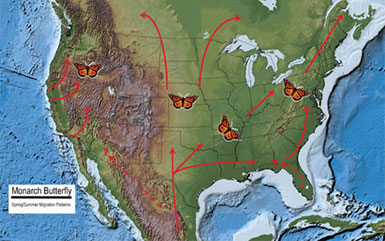While the US Fish and Wildlife Service (FWS) refuses to help wolves, they seem to like the Monarch Butterfly.
FWS announced it will devote $2 million this year to establish the Monarch Conservation Fund – the first dedicated fund for the iconic butterflies.
The plan is to restore 200,000 acres of critical habitat over the next three years that will hopefully keep Monarchs off the endangered species list and help them recover.
Thankfully, Monarch populations bounced back a bit this year.
From California to the Corn Belt, and from Texas to Minnesota, habitats will be restored along the Monarch’s migration route. The money will be used for grants for community groups, businesses and local governments to create "oases for monarchs in communities across the country," in addition to creating pollinator gardens at 750 schools. The money will also be used to expand the supply of native milkweed seeds.
In the spring, Monarchs head north from Mexico:

"We can make habitats for the monarch butterfly in backyards; in school yards; in city, county, state and national parks; in wildlife refuges; in national forests; along right of ways; along roadsides; basically in every tiny patch of open space we can make a habitat for the monarch butterfly. And the magic is if we make the habitat, monarch butterflies will come," says Dan Ashe, head of FWS.
FWS is working with the National Fish and Wildlife Foundation on the project, an organization created by Congress that brings together public and private funds for conservation work. The Foundation is putting in another $1.2 million, to be matched by private and public donors. The other major partner is National Wildlife Federation, but if you look through the projects there are many dozens of groups involved.
"We can save the monarch butterfly in North America, but only if we act quickly and together," says Ashe. "And that is why we are excited to be working with the National Wildlife Federation and National Fish and Wildlife Foundation to engage Americans everywhere, from schools and community groups to corporations and governments, in protecting and restoring habitat. Together we can create oases for monarchs in communities across the country."
Spectacular as it is, protecting the Monarch is not just about saving one species, says FWS. "The Monarch serves as an indicator of the health of pollinators and the American landscape. Monarch declines are symptomatic of environmental problems that pose risks to our food supply, the spectacular natural places that help define our national identity, and our own health. Conserving and connecting habitat for monarchs will benefit other plants, animals and important insect and avian pollinators."
While Ashe acknowledges that spraying GMO crops is largely the cause of Monarch’s decline, he says that efficient weed control on farms is a good thing and doesn’t plan on controlling pesticide use.
That’s even with research showing that glyphosate – the main ingredient in Monsanto’s Roundup – is one of the few herbicides that kills milkweed. With the rise of GMO corn and soy crops in the past 10 years, it’s become the most heavily used pesticide in the US, wiping out 99% of milkweed there.
"We want agricultural production to be as efficient as possible so less acreage has to be used for crops, production," he says. "We have to look for alternative habitats," says Ashe.
The Center for Food Safety disagrees, telling Huffington Post that while planting milkweed and nectar plants are essential to the Monarch’s survival, they will never recover to resilient, healthy levels unless milkweed is restored on agricultural fields. "Research shows that monarch butterflies lay up to four times more eggs on milkweed within agricultural fields," says Larissa Walker, pollinator campaign director.
While glyphosate was little used two decades ago, it has become by far the most heavily used herbicide in the U.S. thanks to glyphosate-resistant Roundup Ready corn and soybean crops, engineered by Monsanto. According to the Center for Food Safety, corn and soybean fields in the Corn Belt have lost 99 percent of their milkweed since 1999.
FWS has created a website to support the effort, showing restoration projects and how schools, communities, farmers and other landowners can help.
Here’s the website:
